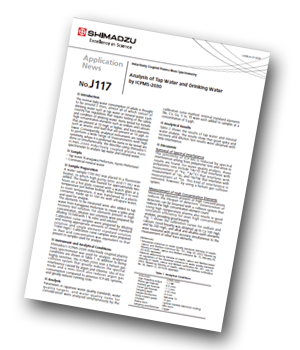Shimadzu has produced an application note describing the simultaneous analysis of tap and mineral water using ICP-MS.
 Introduction
Introduction
The normal daily water consumption of adults is thought to be around 2 liters, almost all of which consist of drinking water such as tap water or mineral water. Each country has regulations that require testing of the safety and condition of drinking water. Items tested for include high concentration elements such as sodium and calcium that are present at 10 mg/L or higher, and trace elements such as arsenic and lead that are present at 10 µg/L or lower. Consequently, analytical instruments are required to perform a wide range of measurements with high sensitivity, where it is preferred the items to be tested are done so simultaneously. This application describes using Shimadzu's ICPMS-2030 inductively coupled plasma mass spectrometer to analyse tap water and mineral water.
Instrument and Analytical Conditions
Shimadzu's ICPMS-2030 inductively coupled plasma mass spectrometer was used for analysis. In addition to being highly sensitive, the ICPMS-2030 uses a helium gas collision system that greatly reduces the spectral interference caused by argon and chlorine. Use of Eco mode and a mini-torch also reduces argon gas consumption compared to previous ICP-MS systems, and greatly reduces running costs.
Analysis
Parameters in Japanese water quality standards, water quality targets, and water quality items for consideration were analysed simultaneously by the calibration curve method. Internal standard elements (Be, Co, Ga, Y, In, Tl) were each added to samples at a concentration of 5 μg/L.
Results and Conclusion
The results show that good spike and recovery and dilution test results were obtained with
little interference. Shimadzu's ICPMS-2030 is shown to be an effective choice for this application.
